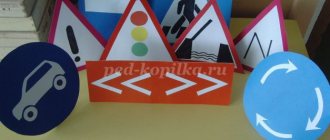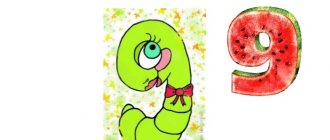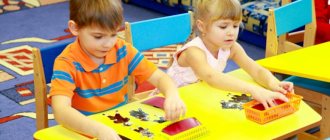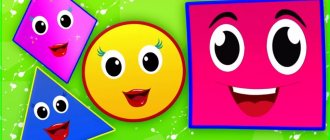Composition of the number 10
An intensive lesson on the composition of the number 10 trains children in counting.
A common stream of knowledge has a beneficial effect on class cohesion. Goal
: consolidate knowledge of the composition of the number 10.
Tasks
:
- improve the ability to perform tasks that require knowledge of the composition of the number 10;
- write down expressions based on the picture or correlate those proposed with the picture;
- perform grouping of numbers;
- identify patterns;
- develop attention, memory, logical thinking, imagination, mathematical speech;
- cultivate interest in the subject, accuracy, sense of camaraderie and mutual assistance.
Equipment
: drawing for the riddle, model of a droplet, cards with numbers, geometric shapes - small and large squares of different colors, drawing of a “magic wheel”, a stack of notebooks, punched cards, a droplet for each student.
Progress of the lesson
Teacher
: Guys, hello. Look outside the window, what time of year is it now?
Children
: Autumn.
Teacher
: What has changed in nature?
Children
: It gets dark early, a cold wind blows, and it rains often.
Teacher
: Indeed, if you look at the window in the rain, it’s all filled with small droplets.
Teacher
: Each of our drops is special, it is not simple and offers you a task. If we quickly and correctly complete the task, then this drop falls into the stream of knowledge, which is still small.
Teacher
: Unravel the rule by which the series of numbers is composed, and continue it (
single-digit numbers only
). 4, 6, 5, 7, 6, …, …, …, …
Children
: 4, 6, 5, 7, 6, 8, 7, 9, 8 (
frontal check
).
Teacher
: Reduce each number in the row by 3. The answers are given on the back of the board.
( Children conduct a self-test
.) 1, 3, 2, 4, 3, 5, 4, 6, 5,
Teacher
: We completed the task, and the first drop falls into the stream of knowledge (
we place a drop in the stream
).
Teacher
: There are cards with numbers 1-9 on the board. I say the task, you must think and choose a card with the desired answer:
- How much greater is the number 8 than the number 4?
- How much is the number 7 smaller than the number 9?
- reduce the number 9 by 3;
- increase the number 2 by 1;
- What is the sum of the numbers 2 and 5?
- what is the difference between the numbers 7 and 6?
Children
: 4, 2, 6, 3, 7, 1 (
frontal check
).
Teacher
: Insert numbers instead of dots to make correct entries.
You can only use the numbers obtained in the first task. … + …=… — … … — …=… — … … + …=… + … ( The task is completed independently in notebooks, then checked at the board. All answer options are considered
.)
Teacher
: We completed the task, and the second drop falls into the stream of knowledge (
we place the drop in the stream
).
Teacher
: Name the numbers that need to be inserted into the “windows”.
( Students name the numbers, go to the board and turn over the cards: 3, 9, 5, 1, 6, 10.
)
Teacher
: Name the extra number.
Children
: 10.
Teacher
: Why?
Children
: Two digits, one ten.
Teacher
: Think about what goal of the lesson we set? For what?
Children
: Repetition and consolidation of the composition of the number 10, so that later you can easily and quickly perform addition and subtraction.
( Message of the topic and objectives of the lesson
.)
Teacher
: We completed the task, and the third drop falls into the stream of knowledge (
we place the drop in the stream
).
Teacher
: I have a stack of notebooks. How many are there?
Children
(
consider
): 5.
Teacher
: I added a few more. How many has it become?
Children
(
consider
): 10.
Teacher
: How many notebooks did I add?
Children
: 5.
Teacher
: How did you get 10?
Children
: 5 + 5=10. (
The expression is written on the board and in a notebook
.)
Teacher
: Figures are given. Name them. On what basis should all figures be divided into two groups so that this corresponds to the expression 5 + 5?
Children
: By color.
( The student at the blackboard divides the figures into two groups by color
.)
Teacher
: By what other criteria can the figures be divided?
Children
: To size.
( The student at the board divides the figures by size into two groups and writes down the expression 6+4=10, 4+6=10. Children write in a notebook
.)
Teacher
: Let's take a break and have some exercise.
Hamster-hamster, hamster, Striped flank. The hamster gets up early, washes his cheeks, rubs his neck. The hamster sweeps the hut and goes out to exercise. One two three four five! Khomka wants to become strong. ( Children imitate all the movements of the hamster
.)
Teacher
: Here is the game “Magic Wheel”.
Arrange the numbers from 1 to 9 so that in any direction along a straight line the total is 10. ( Students go to the board and write down pairs of numbers.
)
Teacher
: Now let’s write new expressions on the board and in the notebook: 1+9=10;
9+1=10; 2+8=10; 8+2=10; 3+7=10; 7+3=10. Read all the expressions ( entries in your notebook
). We completed these tasks, so all the drops fall into the stream of knowledge.
Teacher
: Now we have to work according to the textbook by N.B. Istomina.
( Page 125 No. 291, work in pairs
.) Look at each pair of drawings. What's happening?
Children
: The number of circles increases.
The 1st pair
explains
: the number of red circles was increased by 2, it became 10 (8+2).
2nd pair
: the number of yellow circles was increased by 4, getting 10 (6+4).
3rd pair
: the number of green circles was increased by 5, resulting in 10 (5+5).
4th pair
: the number of blue circles was increased by 3, getting 10 (7+3).
Teacher
: What case is missing?
Children
: 9+1=10
Teacher
: Open your notebooks (TPO). Page 37 No. 79. We complete the first task with an explanation. There are 4 circles in a triangle. What number was used to write this number?
Children
: 4.
Teacher
: How many circles do you need to draw to 1 dozen?
Children
: 6.
Teacher
: How many circles are there in total?
Children
: 10. To write this number, we use two digits: 1 and 0. (
Then the task is completed independently. After completion, check
.)
Teacher
: You have a punched card on your table, with which I will check how you have mastered the composition of the number 10. And I will decide whether to drop our last drop into the stream of knowledge or not after checking the work completed.
Teacher: Let's summarize. What did you repeat in class? Which tasks did you like best? Each of you has a small drop on the table. If you are sure that you know the composition of the number 10 well, and did not have difficulty completing tasks, then your drop falls into the stream of knowledge. If someone is not confident in themselves, let this droplet stay with you for now. And when you are convinced of your knowledge, then drop a drop into the common stream. Maybe it will be tomorrow. ( Children go to the board and drop their drop into the “trickle of knowledge” envelope
.)
Tatyana Gavrilova, primary school teacher, MBOU "Secondary School No. 29
with in-depth study of individual subjects", Smolensk
Development of mathematical concepts. Composition of a number of units (number 10)
Senior group No. 2
Objectives: 1. Improve knowledge about composing a number from units (the number 10). 2. Fasten:
- ordinal and quantitative counting;
- ideas about the immutability of numbers as a result of changes in the way objects are placed in space;
- knowledge about temporary relationships: week, month.
Demonstration material: 10 figurines of birds and animals. Handouts: small toys: nesting dolls, flowers.
Progress of the lesson
Children stand in front of a board, on which the teacher places animals in a row and reads a poem.
We walked at the zoo and counted the animals. This is a bird, this is an animal, Exactly ten of them, check.
Children count animals and birds and tell the teacher how many there are.
One is a cheerful parrot, Two is a panther. Do not snooze! Three is a mischievous monkey, And four is a miracle bird. Behind the peacock is a lion - he is the fifth. Six – striped tiger cub. Seven - a seal swims in the water. Eight is a reindeer. The bear cub is nine, and the tenth is a swan.
- How many birds are there in total? — How did I make up the number 10? - What is the value of a lion? Seal? Teddy bear? - Who is fourth? Sixth? Tenth? — Shall we now count the animals and birds in order?
The teacher thanks the children and invites them to go to the tables on which small toys lie.
— Place in front of you 1 more nesting dolls than 5. — Now let’s make it so that there are 7 nesting dolls. — Now, boys, take 5 flowers. How many flowers did you take? — Give these flowers to the girls. - Girls, how many flowers did the girls give you? Has the number of colors changed? Why? — Return these flowers to the boys. — Boys, how many flowers did the girls give you? Has the number of colors changed? Why?
Children conclude that the number of objects does not change as a result of their movement. The teacher thanks the children and reinforces with them the names of the days of the week.
— Did I forget what day of the week it is? - What will it be like tomorrow? — What day of the week was yesterday? — What day of the week do you not go to kindergarten? — Let us repeat with you the poem with movements:
I did the laundry on Monday, Paul swept on Tuesday. On Wednesday I baked a loaf of bread, I spent all Thursday looking for a ball, I washed the cups on Friday, and on Saturday I bought a cake. I invited all my girlfriends to my birthday party on Sunday.
Next, the teacher reinforces with the children the knowledge of the months of the year.
— What time of year is it now? What month? - What month does the year begin with? - Which month is the hottest? — Name the last month of the year. — Name the second month of autumn. - Name the third month of spring. — What month comes after October?
The teacher thanks the children for their work.
I used fiction, poems by N. Vladimirov, P. Bashmakov.




